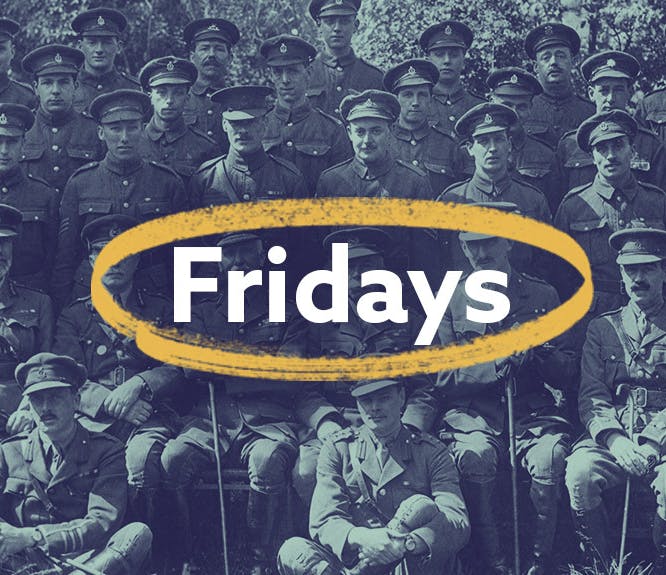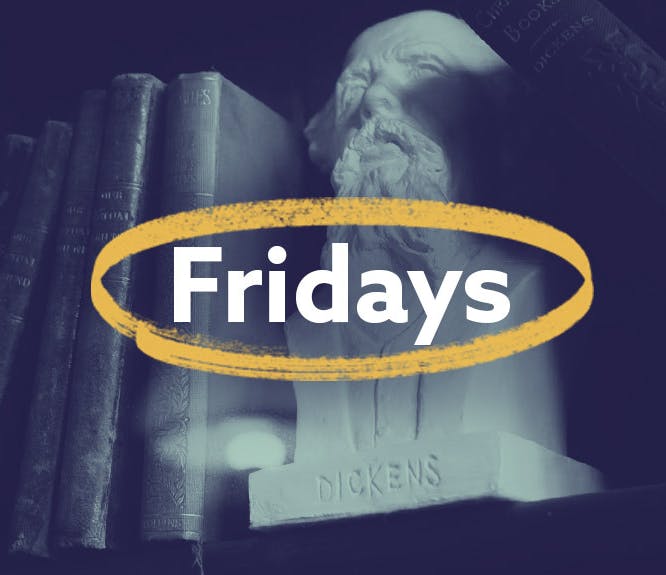A county-by-county guide to Ireland's genealogy records
8-9 minute read
By The Findmypast Team | November 22, 2019
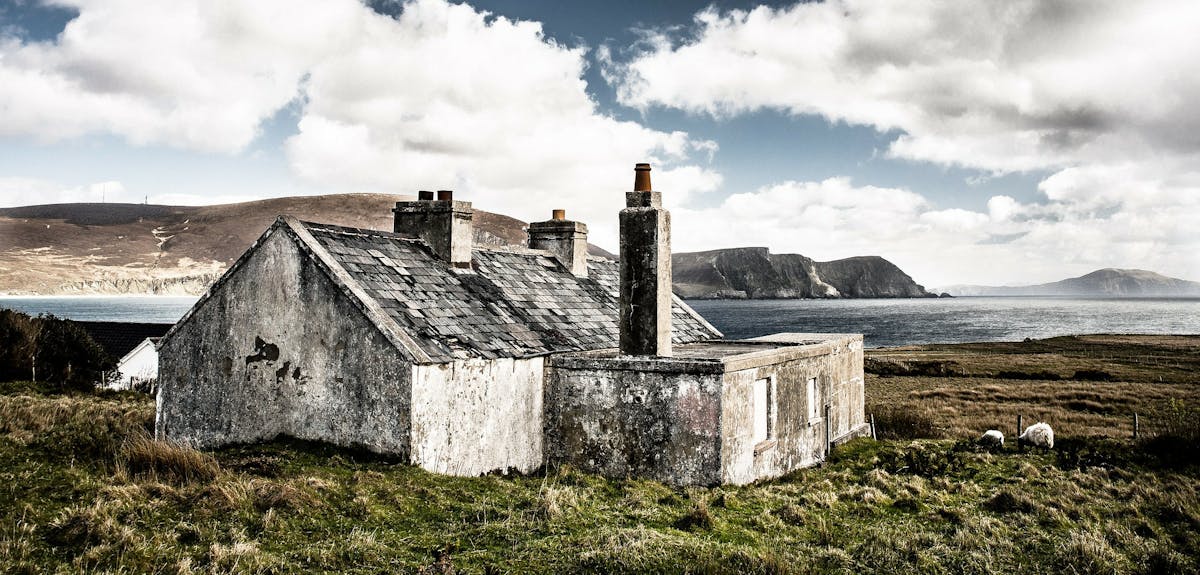
Genealogy in Ireland has a reputation of being really tricky but it doesn't have to be...
To give yourself the best chance of success at genealogy research in Ireland, there is one golden rule - you need as much information as possible about your ancestors before you start. At the very least you need to know their name(s), their date(s) of birth, the names of their siblings and/or parents, and most importantly where in Ireland they came from.
To help you pinpoint your Irish ancestral homestead, we've put this handy guide together. It will take you on a whistlestop tour of Ireland, suggesting some key record collections you should look at for each county.
Ireland's genealogy records
Irish records expert, Brian Donovan talks you through the best resources for tracing Irish ancestors in the below video masterclass. Links to many of the collections he discusses (and more besides) are posted below in our county-by-county guide to Irish family history records.
Ireland is made up of four provinces roughly covering the four corners of the country - Connacht in the west, Leinster in the east, Munster in the south, and Ulster in the north.
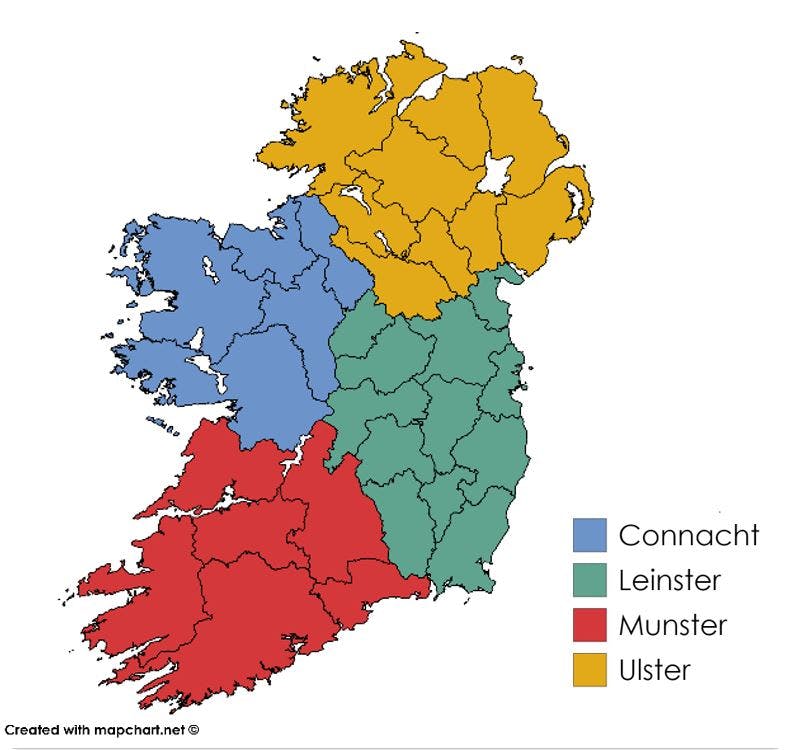
The four provinces of Ireland.
Within those four provinces, there are a total of 32 counties. Here's a quick rundown on the records that will be helpful in your quest to find family connections in each county.
Connacht genealogy
Connacht sits to the west of Ireland with most of its counties touching the coastline of the Atlantic Ocean. There are five counties in Connacht - Galway, Leitrim, Mayo, Sligo and Roscommon.
Galway genealogy records
If your family comes from the City (or county) of Tribes, try searching for their burial records in Memorials Of The Dead: Galway & Mayo or details of their work in Ireland, Poverty Relief Loans 1821-1874, which is particularly useful for tracing elusive ancestors you won't find in other records.
Leitrim genealogy records
'Lovely' Leitrim is one of the least populated counties in Ireland but if your ancestor do hail from these parts, you could trace their details in our Leitrim Cemetery Records or the fascinating Ireland Dog Licence Registers which covers the areas of Carrick-on-Shannon, Drumkeerin, Keshcarrigan and Kinlough.
Mayo genealogy records
The previously mentioned Memorials Of The Dead: Galway & Mayo will help you track family members to Mayo. You'll also find hundreds of thousands of historical newspaper pages from the county online at Findmypast.
Roscommon genealogy records
If you've got ancestors from Roscommon, they may be listed in our unique Ireland Roscommon Kiltullagh Cemeteries. And don't forget, your Roscommon family will also be covered in national collections like Irish Births 1864-1958.
Sligo genealogy records
Exclusive to Findmypast, you could track some of your poorest ancestors in the Sligo Workhouse Admission and Discharge Registers 1848-1859. It's also worth searching Sligo Independent Newspaper, County Directory, Almanac and Guide (1889) and The Sligo Chronicle Almanac and Directory For 1878 for more ancestral leads from the county.
Leinster genealogy
Located in the east and midlands of Ireland, Leinster is the most populated area of the country. Do your family descend from any of Leinster's 12 counties? Carlow, Dublin, Kildare, Kilkenny, Laois, Longford, Louth, Meath, Offaly, Westmeath, Wexford, Wicklow make up the province.
Carlow genealogy records
Explore our archive of historical Carlow Post newspaper pages to find out more about your Carlow ancestry. This county was badly hit by the Great Famine of Ireland during the 19th century, so be sure to also try our Irish Famine Immigrants, 1846-1851 collection, which details those who left Ireland behind for the United States at the time.
Dublin genealogy records
Ireland's capital is steeped in rich history and so too are the stories of your family members who came from there. You'll find Dublin ancestors in millions of records on Findmypast. Highlights include our exclusive Dublin Workhouses Admission & Discharge Registers 1840-1919 and the intriguing Dublin Metropolitan Police Prisoners Books 1905-1908 and 1911-1918.
Kildare genealogy records
Our extensive collection of Irish Catholic Parish Registers cover 23 parishes in County Kildare and date as far back as the 1770s. You'll also find over a rich archive of newspapers from Kildare online at Findmypast.
Kilkenny genealogy records
There are many unique resources you can use to find Kilkenny ancestors. Try George Bassett, Kilkenny City and County Guide and Directory (1884) and Kilkenny Registers & Records, for example. The latter includes a summary of the town of Castlecomer from Ireland's 1901 census.
Laois genealogy records
Formerly known as Queen's County, Laois was home to Maryborough and Queen’s County prisons hundreds of years ago. You'll see their prisoners listed in Irish Prison Registers 1790-1924, perfect for tracing the black sheep in your Laois family.
Longford genealogy records
The ever-popular Irish Petty Sessions Court Registers include 7 courts from County Longford. They'll tell you why your Longford ancestors were hauled in front of their neighbourhood magistrate, as well as vital family tree information like names and addresses.
Louth genealogy records
Just because Louth is Ireland's smallest county, there is no lack of resources you can use to trace family to there. George Bassett, Louth County Guide and Directory (1886) gives an insight into what life was like in Louth during the Victorian period, while Ireland National School Registers cover four of the county's now-defunct primary schools from yesteryear.
Meath genealogy records
Ireland's Royal County isn't all about noble ancestors and blue bloodlines. Griffith's Valuation 1847-1864 is one of the main record collections used for pinpointing families in 19th century Ireland and includes over 57,000 entries from County Meath. A similar substitute land collection, the Landed Estates Court Rentals 1850-1885, features over 18,000 records from the county.
Offaly genealogy records
You might find Offaly described as King's County in family records. Its name changed after Ireland was partitioned from the UK in the 1920s. Either way, there are plenty of chances for you to discover Offaly ancestors on Findmypast. For starters, try the remnants of Ireland Census 1821-1851. The 1821 census survives for large parts of County Offaly.
Westmeath genealogy records
As you might have guessed, this county lies directly to the west of County Meath. Over 28,000 of our exclusive Irish Quaker records relate to Westmeath. Plus, the countrywide Catholic Church registers cover 27 Westmeath parishes dating as far back as 1737 in Mullingar.
Wexford genealogy records
Try the George Bassett, Wexford County Guide and Directory (1885) in your search for Wexford ancestry. Cantwell's Memorials Of The Dead also includes over 36,000 records from the Model County.
Wicklow genealogy records
The 'Garden of Ireland' has an abundance of genealogy records available for you to delve into. Our Wicklow Cemetery Records and Wicklow Registers & Records are just two of the many collections that feature your Wicklow family.
Munster genealogy
The south of Ireland consists of six counties in the province of Munster. Here's where to look to find family stories from Clare, Cork, Kerry, Limerick, Tipperary and Waterford.
Clare genealogy records
Findmypast is home to some exclusive Clare family history collections, making us to the go-to destination for tracing your roots there. For example, you won't find these Clare Electoral Registers or Clare Poor Law Unions Board Of Guardians Minute Books anywhere else online.
Cork genealogy records
Southern Ireland's biggest city and county was also home to one of the biggest emigration ports of the past. That's why you'll find over 800,000 of entries for Queenstown (known as Cobh today) listed in our Passenger Lists Leaving UK 1890-1960. Another useful source of Cork family history is Henry & Coughlan's General Directory Of Cork and Munster For 1867.

Kerry genealogy records
The 'Kingdom' of Kerry was (and still is) one of Ireland's most rural counties. Our Kerry Histories & Reference Guides will paint a picture of what life was like for your ancestors in Kerry, while you'll find a detailed population list for the county in Ireland's oldest fully surviving census from 1901.
Limerick genealogy records
Ireland Valuation Office Books contains over 163,000 records from Limerick. This collection covers a period where little or no census records exist for the county, so could prove really useful as you search for Limerick ancestors. Guy's Limerick Directory, 1912 can also help you trace Limerick roots. It lists names, addresses and sometimes occupations, ideal information for your family tree.
Tipperary genealogy records
As the song goes, "it's a long way to Tipperary", so thankfully you won't need to travel there to explore the county's records. The Tipperary Clans Archive lists indexed gravestone inscriptions from across Ireland, and, as the name suggests, has particularly strong coverage for County Tipperary. Of course, national collections cover this vast county too. Ireland Census 1911 features over 152,000 Tipperary household records.
Waterford genealogy records
Search for your Waterford ancestors in our exclusive Waterford Poor Law Union Board Of Guardians Minute Books or the delve into the eclectic mix of resources in Waterford Registers & Records.
Ulster genealogy
Ireland's North is made up of the nine counties of Ulster - Antrim, Armagh, Cavan, Donegal, Down, Fermanagh, Derry-Londonderry, Monaghan and Tyrone. Three of those counties (Cavan, Donegal and Monaghan) are part of the modern-day Republic of Ireland, while the other six are part of the United Kingdom in Northern Ireland.
Antrim genealogy records
You'll uncover over 100,000 Antrim records in Ireland Calendars Of Wills & Administrations 1858-1920, while The Belfast and Province Of Ulster Directory For 1856 will help you learn more about the fascinating history of Northern Ireland's capital city.
Armagh genealogy records
George Bassett, The Book Of County Armagh (1888) not only helps you find Armagh ancestry, it also provides a well-rounded view of life in the county back in Victorian times. You can also scour over a million historical newspaper articles from Armagh on Findmypast.
Cavan genealogy records
If your family hail from County Cavan, try searching for them in Cavan Registers & Records, which includes the 1821 Census for the parish of Crosserlough. Of course, Cavan is also covered in national record collections. For example, there are over 5,000 Cavan entries in our Royal Irish Constabulary Service Records 1816-1922.
Donegal genealogy records
Often dubbed 'The Forgotten County' due to its remote location in the North West of Ireland, Donegal is anything but neglected on Findmypast. Donegal Workhouses Registers and Minute Books span from 1840 to 1922 and include over 400,000 records of Donegal ancestors. You can both search and browse this extensive resource and you'll only find it online at Findmypast.
Down genealogy records
County Down ancestry? Trace it in George Bassett, County Down Guide and Directory (1886). You'll also find an exclusive collection of parish records from Annaclone, on Findmypast, covering both the Church of Ireland and Roman Catholic faiths.
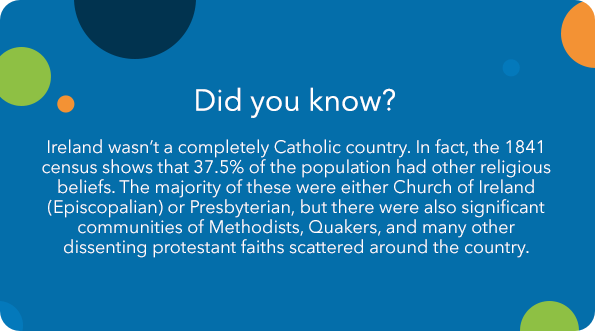
Fermanagh genealogy records
If you've got roots in Fermanagh, our county collections of cemetery records and parish registers will help you piece the puzzle of your family's past together. And for an insight into 19th-century life in the Lakeland County, Macloskie's Directory Of Fermanagh 1848 is worth a look.
Londonderry (Derry) genealogy records
The Register Of Derry Cathedral 1642-1703 is one of the oldest Irish record collections on Findmypast and includes over 33,000 records, perfect for taking your Londonderry (Derry) family research back further. Meanwhile, Ireland Billion Graves Cemetery Index contains over 23,000 burial records from the Oak Leaf county.
Monaghan genealogy records
Our indexes of civil births, marriages and deaths hold over 700,000 records from County Monaghan combined. You'll also find Monaghan ancestors well-represented in Crossle Genealogical Abstracts, a unique resource made up of the notebooks of Irish genealogists Dr Francis Crossle and his son Philip.
Tyrone genealogy records
One of Northern Ireland's biggest counties has the record resources to match on Findmypast. Try searching for family members' final resting places in our collection of Tyrone Cemetery Records. Plus, Ireland Census Search Forms 1841 & 1851 has almost 5,000 Tyrone records in it.
Hit a brick wall? Hire a genealogist
If you need a helping hand with your Irish genealogy research, there are experienced professionals who can do the heavy lifting for you. In Ireland, we work in partnership with the Irish Family History Centre. As their name suggests, they specialise in bespoke Irish family research and have helped to uncover Irish connections for Tom Cruise, Barack Obama and Justin Trudeau.


